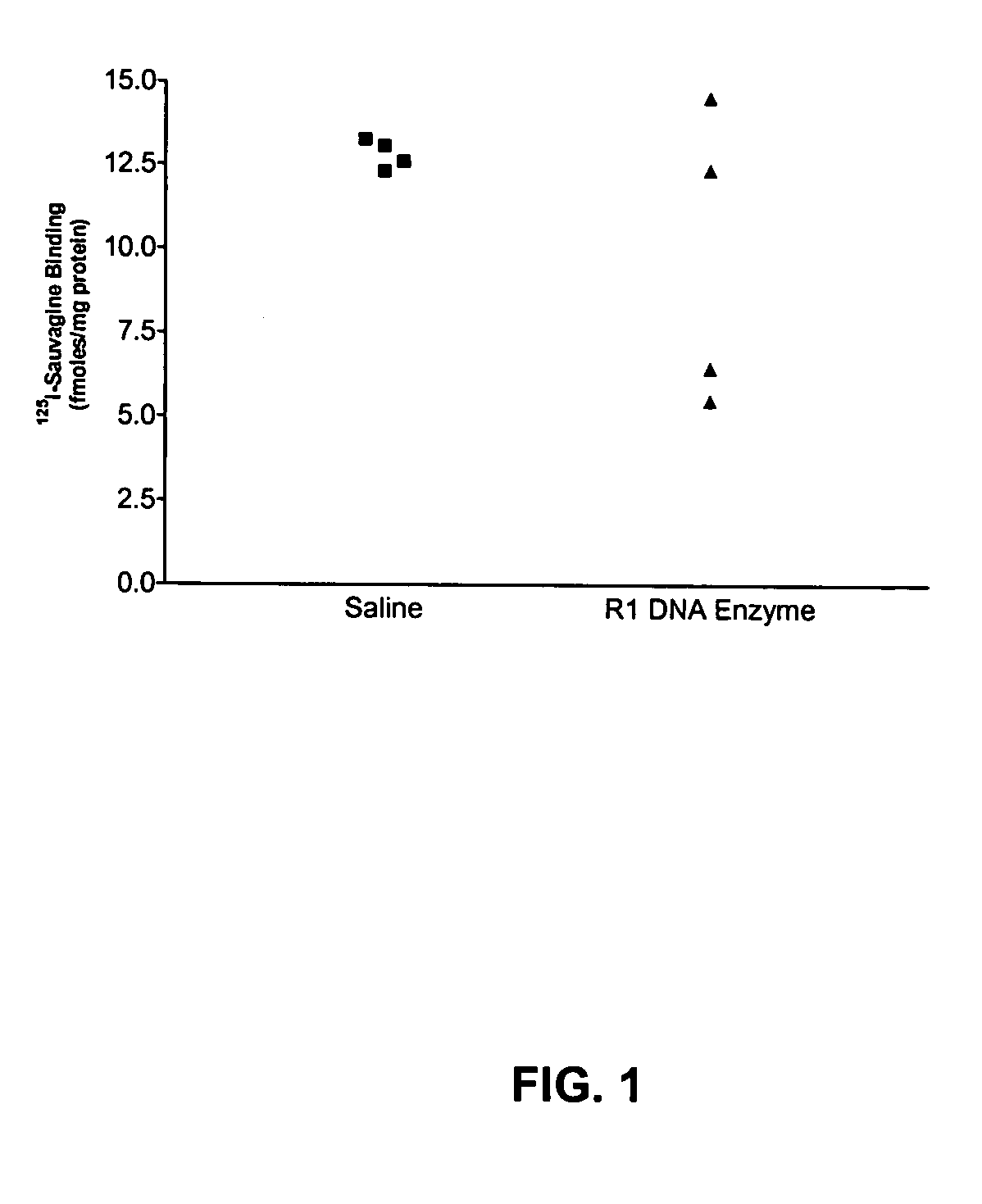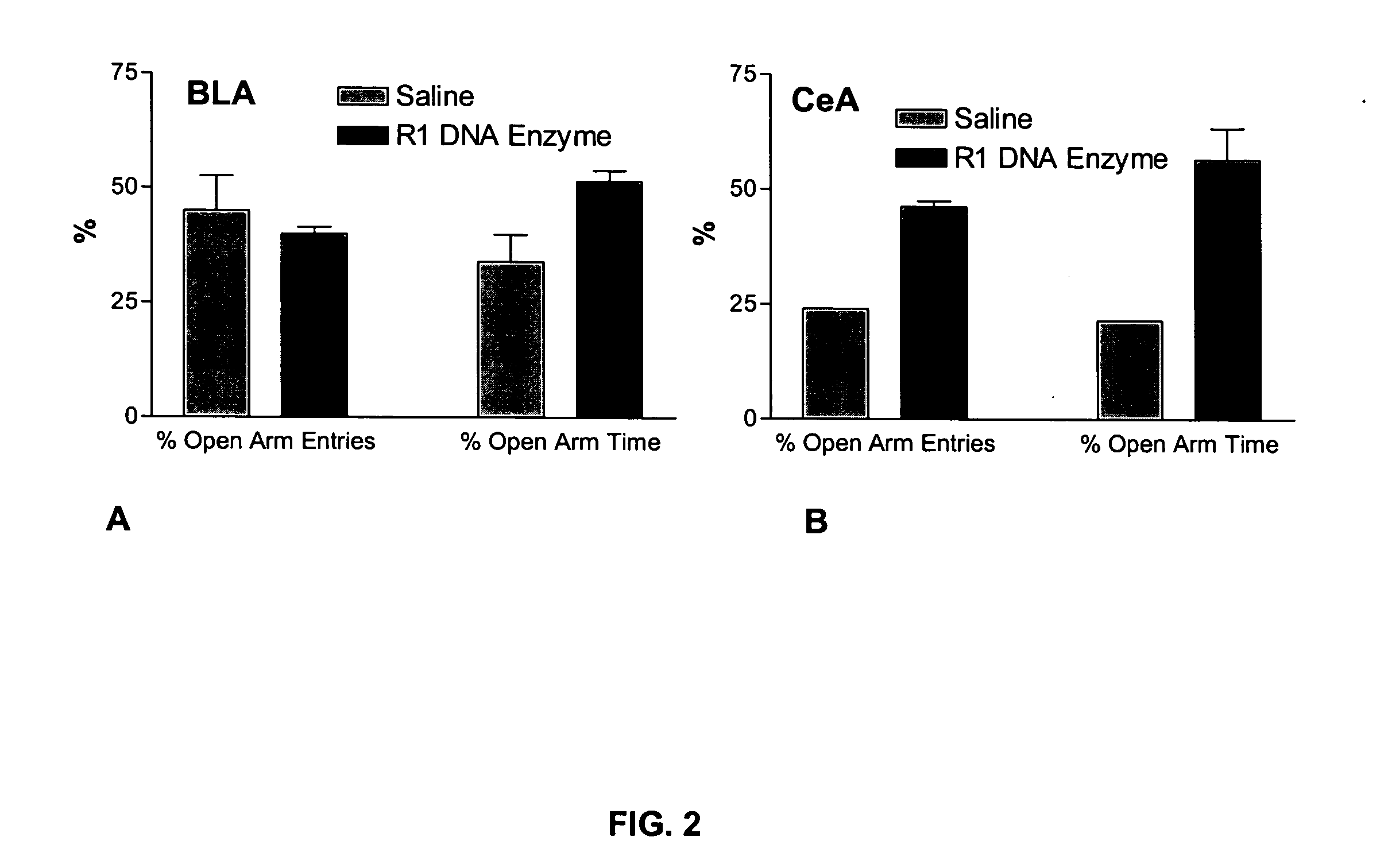Method of reducing CRF receptor mRNA
a technology of mrna and crf receptor, which is applied in the field of reducing crf receptor mrna, can solve the problems of affecting cardiovascular function, affecting immune function and gastrointestinal physiology, and affecting so as to achieve the effect of reducing the amount of corticotrophin releasing factor receptor
- Summary
- Abstract
- Description
- Claims
- Application Information
AI Technical Summary
Problems solved by technology
Method used
Image
Examples
example 1
Infusion of a Nucleic Acid Enzyme Specific for CRF1 into Rat Brain Enzyme Infusion
[0067] Male Sprague-Dawley rats were equipped with bilateral stainless steel guide cannulae aimed at either the central nucleus (CeA) or the basolateral nucleus (BLA) of the amygdala. Stereotaxic coordinates (based on the atlas of Paxinos and Watson, 1986) were as follows: CeA—anterior / posterior plane=−2.0 mm from bregma; lateral / medial plane=±4.0 mm from midline; dorsal / ventral plane=−5.2 mm from skull surface. BLA—anterior / posterior plane=−3.0 mm from bregma; lateral / medial plane=±5.0 mm from midline; dorsal / ventral plane=−5.8 mm from skull surface. Two weeks after surgeries, injectors were lowered through the guide cannulae to the final dorsal / ventral coordinates (−8.2 mm for the CeA, and −8.8 for the BLA), and each side received 20 μg of the CRF1 receptor nucleic acid enzyme infused at a concentration of 20 μg / μl and at a rate of 0.65 μl / min. This procedure was carried out once a day for 5 consecu...
example 2
Characterizing the Effects of a Nucleic Acid Enzyme Targeting CRF2α Receptors on CRF2α in vitro Expression
[0075] In order to test the effectiveness of the CRF2α nucleic acid enzyme, we made use of the TnT Coupled Reticulate Lysate in vitro transcription / translation system (Promega, Madison, Wis.). In this system a linearized full-length human CRF2α cDNA was used as template. The TnT system, in a single reaction tube, will both transcribe mRNA from the template and translate the mRNA into protein. Test reactions included 1 μg of a nucleic acid enzyme designed against the human CRF2α mRNA. All reactions included 35S methionine so that the amount of translated protein could be determined. Completed reactions were run on SDS-PAGE gels, the gels were dried on to Whatman paper, exposed to phosphorimaging screens, and imaged using a STORM phosphorimager (Molecular Dynamics, N.J.). The radioactive signal from the band corresponding to the CRF2α protein was determined with the ImageQuant so...
example 3
Infusion of a Nucleic Acid Enzyme Specific for CRF2 into Rat Brain Enzyme Infusion
[0077] Male Sprague-Dawley rats were equipped with bilateral stainless steel guide cannulae aimed the lateral septum (LS). Stereotaxic coordinates (based on the atlas of Paxinos and Watson, 1986) were as follows: LS—anterior / posterior plane=+0.4 mm from bregma; lateral / medial plane=±0.8 mm from midline; dorsal / ventral plane=−5.0 mm from skull surface. One week after surgeries, injectors were lowered through the guide cannulae to the final dorsal / ventral coordinates (−7.5 mm for the LS), and the R2 nucleic acid enzyme was infused at a concentration of 20 μg / μl / side or 100 μg / μl / side. This procedure was carried out once a day for 5 consecutive days; control animals for each brain region received the same regimen of infusions, but received isotonic saline instead of the nucleic acid enzyme.
[0078] Behavioral Testing
[0079] Two hours after the 5th infusion, all rats were tested for anxiety-like responses ...
PUM
| Property | Measurement | Unit |
|---|---|---|
| concentration | aaaaa | aaaaa |
| thick | aaaaa | aaaaa |
| concentration | aaaaa | aaaaa |
Abstract
Description
Claims
Application Information
 Login to View More
Login to View More - R&D
- Intellectual Property
- Life Sciences
- Materials
- Tech Scout
- Unparalleled Data Quality
- Higher Quality Content
- 60% Fewer Hallucinations
Browse by: Latest US Patents, China's latest patents, Technical Efficacy Thesaurus, Application Domain, Technology Topic, Popular Technical Reports.
© 2025 PatSnap. All rights reserved.Legal|Privacy policy|Modern Slavery Act Transparency Statement|Sitemap|About US| Contact US: help@patsnap.com



